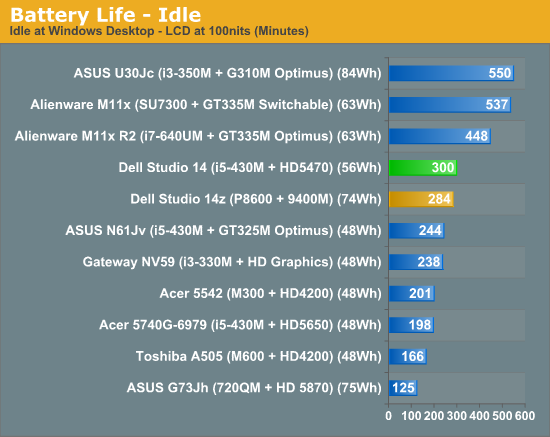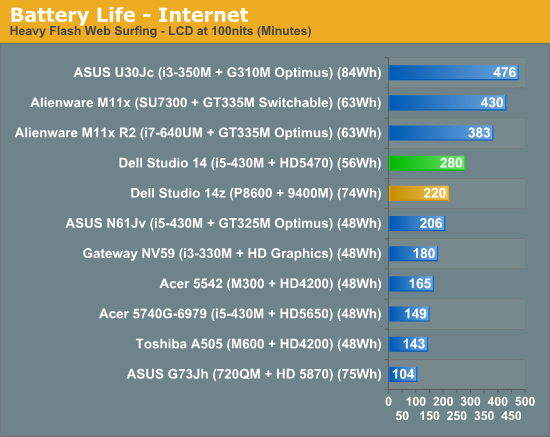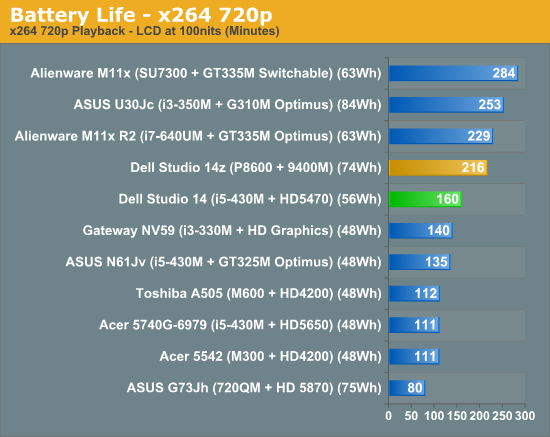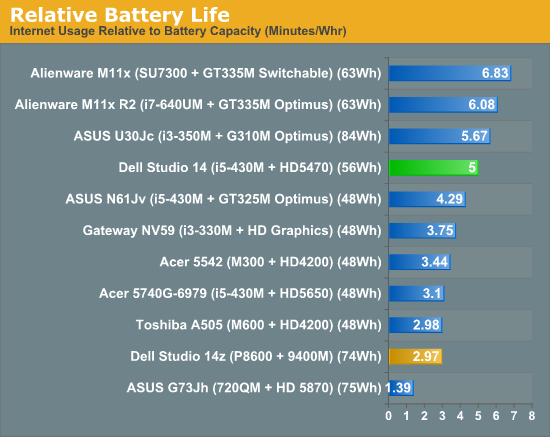Dell Studio 14: Defining Solid
by Dustin Sklavos on August 19, 2010 2:49 AM ESTStudio 14 Battery Life
So far, our review unit has shown us solid performance in applications and about the best performance we could ask for in gaming (given the lousy options presented), but an increasingly important metric these days is battery life. We expect good things out of the Studio 14: the high capacity 6-cell, 56Wh battery should be able to get us at least four hours of useful life out of the notebook.




Getting close to three hours of movie playback time is pretty reasonable; in fact it starts scraping under machines with integrated graphics and bigger batteries. Under internet usage it gets even better, with the Studio 14 pulling nearly five hours of useful life at a comfortable brightness. Dell's done their homework here: the battery life on our Studio 14 is miles ahead of their last generation. The exception to that statement is x264 playback, where the old 9400M IGP of the 14z surpasses the new 14, though it had a larger battery. Note that on a per Wh metric, the 14z scored 2.92 compared to 2.86 on the 14, so it's pretty close even in that case. The dedicated graphics may be extremely low-powered but the chip still draws more power than the integrated graphics would have, and there's no indication that the Studio 14 is switching between the two.
Given the excellent running time from the stock 6-cell battery, we feel comfortable recommending users who need more than five hours of life opting for the 9-cell. Dell's site suggests that extended battery can last for up to eight hours and thirty-five minutes (how delightfully specific), and it's reasonable to assume they aren't far off the mark.










52 Comments
View All Comments
JarredWalton - Thursday, August 19, 2010 - link
Windows 7 does use VRAM to cache windows, saving some system RAM and helping to smooth out Aero a bit. Outside of that edge case, if you haven't actually used a current Intel HD Graphics solution, you are way off base on most of the other complaints.OpenGL used to be horrible on ATI as well back in the day, and it was really 3dfx that started the consumer interest with glQuake--prior to that, no one outside of professionals really cared about the API.
Today, OpenGL is becoming a minor player compared to DirectX. Professional apps still use the API, but there are a ton of users that will never even use an OpenGL tool. Even if they do, my experience is that the Intel HD Graphics are at about the same level as ATI's HD 4200 series, with a few things like DX10 games not always running properly (but who cares at single digit frame rates?)
All things being equal, yes I'd prefer an NVIDIA or ATI GPU over an Intel IGP. That said, on a laptop you have to worry about power, and in that case you want switchable graphics. NVIDIA's Optimus trumps ATI's switchable tech right now, though it's not without a few concerns (i.e. Linux support). Anyway, the real problem is this entry-level GPU crap being foisted onto unaware consumers for $150 extra. For $150 you should get an HD 5650. I'm not sure they couldn't get it in there on the heat side either, considering you have GT 335M in 14" and 13" laptops. But then GT 335M would probably be better, since it has Optimus and you could still get the 6 hours of battery life.
ESetter - Thursday, August 19, 2010 - link
I'm glad to here the Intel drivers are better nowadays, but just 4 years they were quite buggy. I've never had problems on ATI GPUs in the last 6-7 years, though.If you look at the battery life charts, this notebook seems comparable to similar models with integrated graphics and similar batteries. The power consumption of these entry level GPUs is very low at idle.
In the end it all depends on what you're looking for, but in my opinion there is still reasons to get entry level ATI/nVidia GPUs.
mino - Thursday, August 19, 2010 - link
They are still, and NOT getting better.For example during their latest driver refresh with Win7 & i7 they managed to remove display profiles ...
So now EVERY single time I plug/unplug notebook to display device I have to manually configure everything.
Funny thing is that Intel was the first with profiles - it was the only thing they had better even ~5 yrs ago ...
yyrkoon - Sunday, August 22, 2010 - link
There are no major issues with Intels mobile graphics solutions. Where the issue lies, is the end user not doing enough research on hardware they can afford for certain task(s).I myself own a laptop, with Intel 4500 IGP, and am surely a little disappointed in its performance for certain situations. With that said, I did look into the situation before I made my purchase, and am willing to live with my decision. Blaming Intel for my mobile choice in graphics only serves to make me look foolish, and accomplishes nothing else.
Inform yourself. Then if something does not work for you, do not buy the technology. Intel, and the other technology companies out there are not in the fire fighting business. But they are more than willing to extinguish many a fire, by accepting that hard earned cash burning a hole in your pocket.
hybrid2d4x4 - Thursday, August 19, 2010 - link
I think you hit the nail on the head here, rootheday. If you don't game, you don't gain anything from "moving up" from integrated. And if you do intend to play games, these bottom-of-the-barrel solutions aren't going to give you a good experience unless all you want to do is play the good games you missed 3-7 years ago. The one thing I think they do right (and I'm probably in the minority here) is that they at least use low-res 768p displays- I'd hate to see single digit FPS @ native res on a higher res display. If only they made GOOD QUALITY, MATTE 768p displays...As an aside, I've seen some notebooks that advertise switchable graphics with the ATI 5 series. Any chance one of those might be finding it's way for review?
futurepastnow - Thursday, August 19, 2010 - link
If it's not adequate for playing games, then why bother with a discrete GPU in the first place?If the integrated graphics are good enough for non-gaming use (and they are), then the GPU is just a leech.
cknobman - Thursday, August 19, 2010 - link
Sell it for a decent base price but add any meaning full upgrades to it and the consumer gets raped.My Sonly 14'CW has a Intel i520 cpu and gforce 330 in it and also has 4gb ram and a 500gb hd and it was $900 just like the dell.
Dell needs to stop the business practice of trying to lure people in with low base prices and then gouge them on upgrades, its downright despicable and frustrating and the sole reason why I have never purchased a dell and probably never will.
Hxx - Thursday, August 19, 2010 - link
Dell almost always has the studio lineup on some sort of sale so if you do some research you will end up paying around 700 for a config that would otherwise be 900. I got mine for 660 back in april when studios were going for arround 1k.Either way this is a great laptop for the price and Dell does what everyone else does when it comes to imflating prices on upgrades.
mino - Thursday, August 19, 2010 - link
I feel Dustin that you at AT are a bit too comfortable using HD5850 a "low-end" rig.For a WORK/BUSINESS notebook anything above current AMD/NVDA low-end mobile GPU's is not feasible from the power POW.
That is, at 40nm.
We can hate TSMC/Glofo for that, but that is about it.
ismailfaruqi - Thursday, August 19, 2010 - link
Could you review HP 8540w with Dreamcolor 2 display configuration? It has 15 inch, IPS, 10-bit screen that maybe the answer for anyone dreaming laptop with excellent screen. Also could you measure its power consumption, because when configured with Dreamcolor 2 the power brick should be changed to 150W.